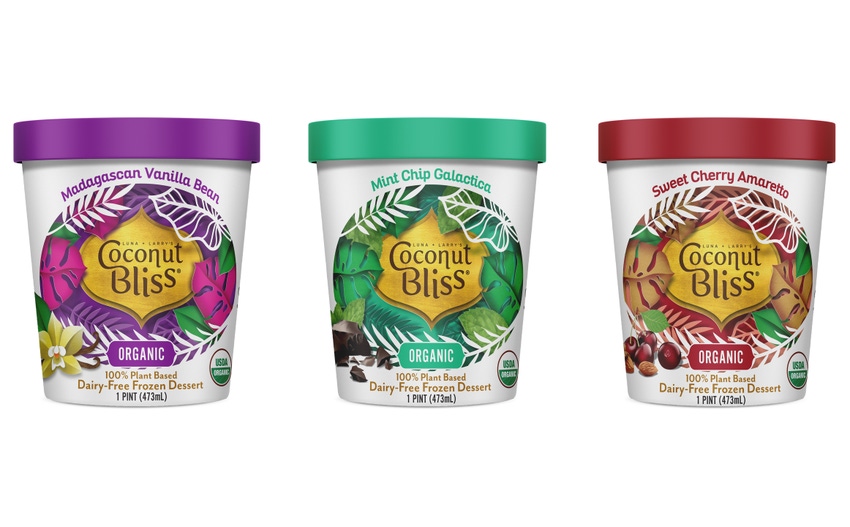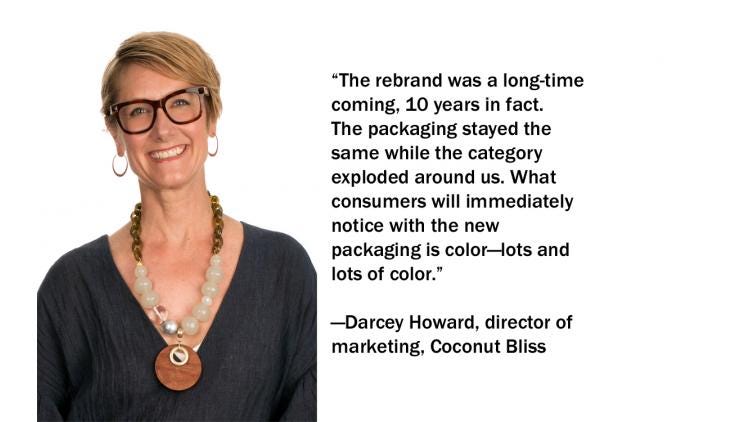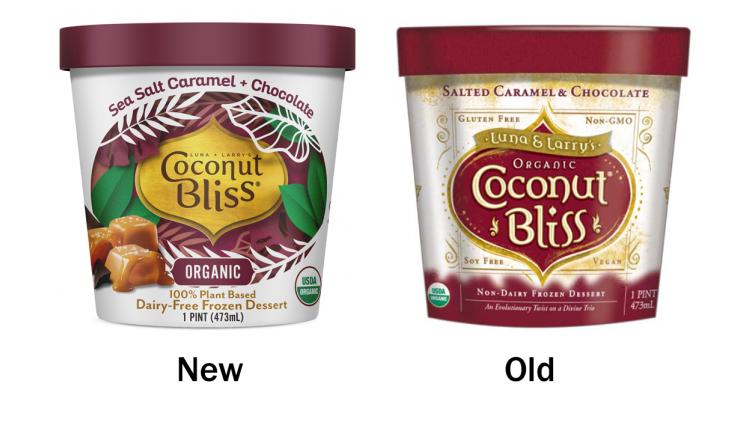January 13, 2020

Coconut Bliss’s redesigned, sustainable paperboard-cup packaging is a category-first material protected by a biopolymer made from sugarcane husks.
Family-owned Coconut Bliss of Eugene, OR, artfully and sustainably redesigned the packaging from the inside out for all its cupped frozen desserts.
On the printed exterior, the products' rich taste is the focus of the graphics design, depicted through illustrations of each flavor’s tasting notes to showcase the high-quality ingredients.
“Since 2005, Coconut Bliss has been committed to using certified organic and ethically-sourced ingredients of the highest quality,” says Kim Gibson Clark, president and CEO of Coconut Bliss. “For our first brand refresh, the goal was to push ourselves to create a cohesive new design reflecting the passion, purpose and taste of Coconut Bliss that has delighted our dedicated fans for years. I am happy to say that we have accomplished our goal.”
The new-look graphics are paired with a first-of-its-kind eco-friendly pint packaging as part of Coconut Bliss’ commitment to sustainability that makes it the first frozen dessert or ice cream brand to use plant-based bio resin polyethylene pint-cup packaging. Made of 97% bio-based resources, the material is Evergreen Packaging’s Sentinel Renewable Ice Cream Board extruded with Braskem’s “I’m green” brand polyethylene made from sugarcane that's an environmentally-friendly alternative to traditional petroleum-based PE resin.
“As a USDA Certified Organic and Non-GMO Project Verified company, Coconut Bliss is always looking for ways to limit its environmental footprint,” Clark explains. “That’s why, in conjunction with our ambitious rebrand, we are so excited to introduce this cutting-edge packaging that performs like traditional ice cream packaging, without the same environmental concerns. Plus, we love the fact that our plant-based ice cream is now served in plant-based packaging.”
The time was ripe for the changes, Darcey Howard, director of marketing, tells Packaging Digest.

“The rebrand was a long time coming, 10 years in fact. The hand-packed, small-batch vegan ice cream grew to an internationally distributed contender in the dairy-free space, yet the packaging stayed the same as the category exploded around us. Our old packaging was muted and dated and was entirely lost on shelf, an impact that we felt. What consumers will immediately notice with the new packaging is color—lots and lots of color, with complimenting white space.”
The changeover was in the works for a little over a year, Howard adds, and discloses more details in this Q&A.
What were the design goals?
Howard: The sustainable packaging itself was an internal project spearheaded by our Sustainability Director, Kate Campbell. The major design goals for the new look included:
Expressing the plant-based and organic nature of the product;
Creating design elements that can be used independently or together;
Communicating the flavor cues found in our ice cream;
Displaying the super-premium quality of the product;
Incorporating plant elements found in the ingredients;
Significant shelf pop.
The design was handled by Revolution Design Group.
What sparked the idea to use a bioplastic-based coating in the first place?
Howard: All of Coconut Bliss’ ingredients are sustainably sourced and certified organic, which is part of our DNA and will never change. Occasionally we’d get customers that asked how it is that we’d make such a beautiful, sustainable product but then package it in what was “sustainable garbage.”
Unfortunately, there were no options on the market for anything other than petroleum-based, resin-lined ice cream cup packaging. We worked with Stanpac, who then worked with Evergreen and Braskem to source and create a bio-polymer resin made from sugarcane husks. We've worked directly with Stanpac as our supplier for the past five or six years, which sought out Evergreen as a partner for this.It's our first time using Evergreen packaging.
What are the lids' material?
Howard: The cups are made of recycled paperboard and come to us from Stanpac, including the premade, preprinted lid.
Is the new bio-based container called out on the label? Is the container marked for recycling?
Howard: The packaging carries the Evergreen logo to identify that it is sustainable. The significance of that will likely be lost on most consumers, but for the ones that care or are curious we have information accessible on our website. All of our customer service team is training as part of the process. The greater significance is in our ability to close the loop on our mission and commitment to the environment.

Why is the timing ripe for this sustainable material and how is it better than what you used before?
Howard: Anything is better than petroleum-based products. It’s exciting to be the first ice cream brand in the market to have this more sustainable packaging, but that wasn’t entirely the goal. The goal is to get as many other brands to convert to this, making a bigger eco-impact and ultimately making the cost of producing lower.
Was there a challenge to switching to the new packaging?
Howard: We’ve seen absolutely no difference in the performance of the bio-polymer, so from that perspective it’s been seamless.
However, it was a challenge to source, it took a long time to produce and it comes a slightly higher cost. Stanpac is giving us a price break on it in hopes that we’ll be able to help the word out there and bring more brands in.
What are your expectations for more bio-based plastics in food packaging?
Howard: We can keep coming up with ways to recycle or teach people about the impacts of plastics, but until brands start demanding alternatives and make it part of their mission, like we did, there won’t be financial motivation for manufacturers to develop alternatives. It starts with straws and plastic shopping bag bans, then goes to clamshells and shrink wrap.
The more brands that make this transition to bio-polymer resin for ice-cream cups, the more we all win.
You May Also Like


